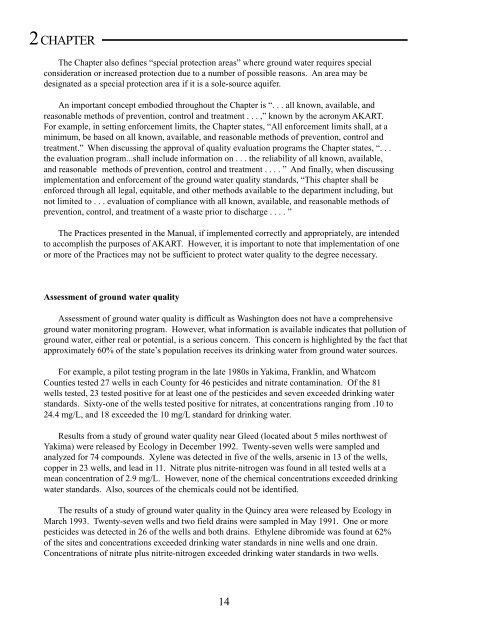Em4885 irrigation management practices to protect ground water
Em4885 irrigation management practices to protect ground water
Em4885 irrigation management practices to protect ground water
You also want an ePaper? Increase the reach of your titles
YUMPU automatically turns print PDFs into web optimized ePapers that Google loves.
2 CHAPTER<br />
The Chapter also defines “special <strong>protect</strong>ion areas” where <strong>ground</strong> <strong>water</strong> requires special<br />
consideration or increased <strong>protect</strong>ion due <strong>to</strong> a number of possible reasons. An area may be<br />
designated as a special <strong>protect</strong>ion area if it is a sole-source aquifer.<br />
An important concept embodied throughout the Chapter is “. . . all known, available, and<br />
reasonable methods of prevention, control and treatment . . . ,” known by the acronym AKART.<br />
For example, in setting enforcement limits, the Chapter states, “All enforcement limits shall, at a<br />
minimum, be based on all known, available, and reasonable methods of prevention, control and<br />
treatment.” When discussing the approval of quality evaluation programs the Chapter states, “. . .<br />
the evaluation program...shall include information on . . . the reliability of all known, available,<br />
and reasonable methods of prevention, control and treatment . . . . ” And finally, when discussing<br />
implementation and enforcement of the <strong>ground</strong> <strong>water</strong> quality standards, “This chapter shall be<br />
enforced through all legal, equitable, and other methods available <strong>to</strong> the department including, but<br />
not limited <strong>to</strong> . . . evaluation of compliance with all known, available, and reasonable methods of<br />
prevention, control, and treatment of a waste prior <strong>to</strong> discharge . . . . ”<br />
The Practices presented in the Manual, if implemented correctly and appropriately, are intended<br />
<strong>to</strong> accomplish the purposes of AKART. However, it is important <strong>to</strong> note that implementation of one<br />
or more of the Practices may not be sufficient <strong>to</strong> <strong>protect</strong> <strong>water</strong> quality <strong>to</strong> the degree necessary.<br />
Assessment of <strong>ground</strong> <strong>water</strong> quality<br />
Assessment of <strong>ground</strong> <strong>water</strong> quality is difficult as Washing<strong>to</strong>n does not have a comprehensive<br />
<strong>ground</strong> <strong>water</strong> moni<strong>to</strong>ring program. However, what information is available indicates that pollution of<br />
<strong>ground</strong> <strong>water</strong>, either real or potential, is a serious concern. This concern is highlighted by the fact that<br />
approximately 60% of the state’s population receives its drinking <strong>water</strong> from <strong>ground</strong> <strong>water</strong> sources.<br />
For example, a pilot testing program in the late 1980s in Yakima, Franklin, and Whatcom<br />
Counties tested 27 wells in each County for 46 pesticides and nitrate contamination. Of the 81<br />
wells tested, 23 tested positive for at least one of the pesticides and seven exceeded drinking <strong>water</strong><br />
standards. Sixty-one of the wells tested positive for nitrates, at concentrations ranging from .10 <strong>to</strong><br />
24.4 mg/L, and 18 exceeded the 10 mg/L standard for drinking <strong>water</strong>.<br />
Results from a study of <strong>ground</strong> <strong>water</strong> quality near Gleed (located about 5 miles northwest of<br />
Yakima) were released by Ecology in December 1992. Twenty-seven wells were sampled and<br />
analyzed for 74 compounds. Xylene was detected in five of the wells, arsenic in 13 of the wells,<br />
copper in 23 wells, and lead in 11. Nitrate plus nitrite-nitrogen was found in all tested wells at a<br />
mean concentration of 2.9 mg/L. However, none of the chemical concentrations exceeded drinking<br />
<strong>water</strong> standards. Also, sources of the chemicals could not be identified.<br />
The results of a study of <strong>ground</strong> <strong>water</strong> quality in the Quincy area were released by Ecology in<br />
March 1993. Twenty-seven wells and two field drains were sampled in May 1991. One or more<br />
pesticides was detected in 26 of the wells and both drains. Ethylene dibromide was found at 62%<br />
of the sites and concentrations exceeded drinking <strong>water</strong> standards in nine wells and one drain.<br />
Concentrations of nitrate plus nitrite-nitrogen exceeded drinking <strong>water</strong> standards in two wells.<br />
14
















